The Economics and Statistics Division maintains archives of previous publications for accountability purposes, but makes no updates to keep these documents current with the latest data revisions from Statistics Canada. As a result, information in older documents may not be accurate. Please exercise caution when referring to older documents. For the latest information and historical data, please contact the individual listed to the right.
<--- Return to Archive
For additional information relating to this article, please contact:
April 21, 2022EMPLOYMENT INSURANCE, FEBRUARY 2022 From March to September 2020, Statistics Canada suspended publication of employment insurance (EI) statistics. Canadians were eligible for the Canada Emergency Response Benefit (CERB) during this period. Data for the period from March to September 2020 shows how an initial rise in EI claims at the start of the pandemic was reversed as new EI applicants were directed to CERB instead. After September 27, 2020 there was a temporary expansion of EI and CERB recipients were transitioned back to EI. Temporary changes, including a reduction in the number of insurable hours required for eligibility, ended in September 2021.
The information released today for February 2022 reflects the period of February 13 to 19. Many health measures had been eased by the February reference week. Several provinces had lifted, or were in the process of lifting proof-of-vaccination requirements and capacity limits in settings such as restaurants, retailers, theatres and gyms.
In February, there were 30,110 Nova Scotians in receipt of regular EI (seasonally adjusted) benefits. Nova Scotia's seasonally adjusted regular EI usage declined by 1,210 (-3.9%) from January to February.
There were 564,690 Canadians that received regular EI benefits in February (seasonally adjusted), a decrease of 68,370 (-10.8%) from January. All provinces with the exception of Prince Edward Island reported declines in regular beneficiaries this month.
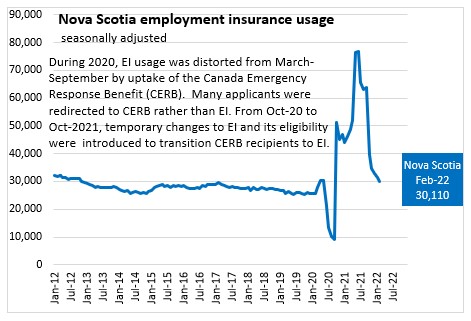
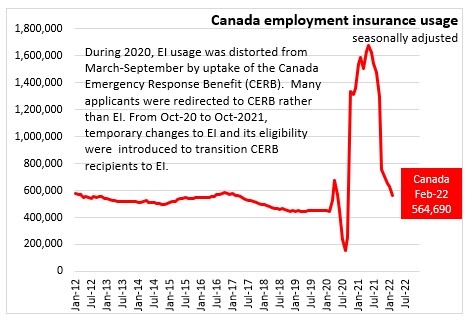

As a percentage of the labour force, employment insurance beneficiaries reflect 5.9% of the labour force in Nova Scotia in February 2022. Nationally, the share of beneficiaries was 2.7% of the labour force. Employment insurance beneficiaries reflect a larger share of the labour force in Atlantic Canada. All provinces reported higher EI proportions than February 2020.
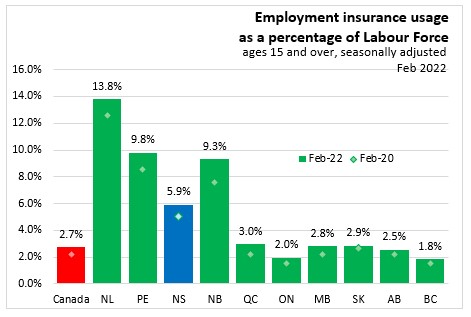
When compared to February 2020, EI usage has increased 26.5% across Canada as of February 2022. In Nova Scotia, EI usage was up 18.1% compared to the pre-pandemic benchmark. The largest percentage increases in EI usage were in Ontario and Quebec. The smallest increases in EI usage were reported in Saskatchewan and Newfoundland and Labrador.
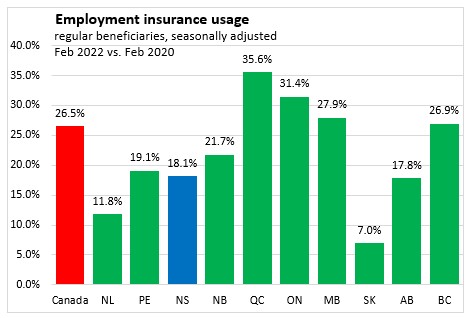
By age and sex cohort, the increase in EI usage has been notably higher among women since the onset of the pandemic (Feb 2022 vs Feb 2020, seasonally adjusted). The industries whose employment was most affected by public health restrictions and other pandemic precautions had a disproportionate share of female employment.


In February 2022, EI beneficiaries reflect a larger share of the labour force for males and for those aged 55 and over.
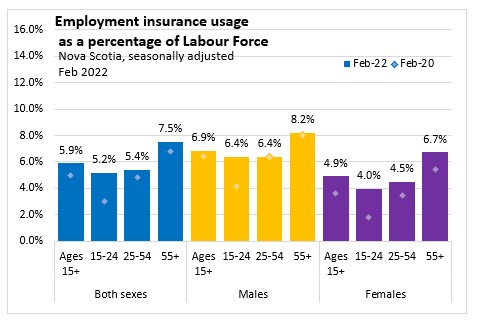
All occupational categories, except trades &transportation, saw increases in EI usage in Nova Scotia for Jan-Feb 2022 compared to the same period in 2020. Sales and service occupations has the largest increase in usage compared to before the pandemic.
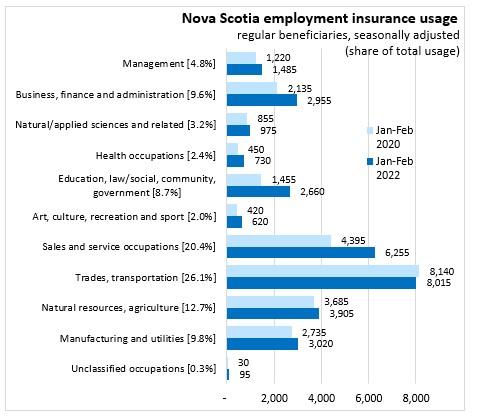
Among counties (comparing unadjusted results for February 2022 with February 2020), EI usage increased the fastest in Queens, Halifax and Yarmouth counties. EI usage was lower in Inverness.

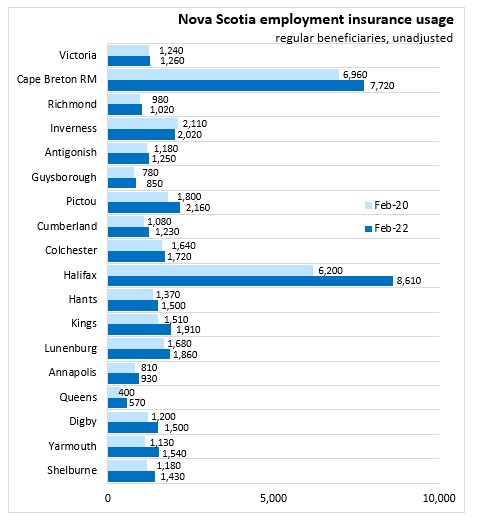
Source: Statistics Canada. Table 14-10-0011-01 Employment insurance beneficiaries (regular benefits) by province and territory, monthly, seasonally adjusted
Table 14-10-0323-01 Employment insurance beneficiaries by census division, monthly, unadjusted for seasonality
Table 14-10-0337-01 Employment insurance beneficiaries (regular benefits) by province, territory and occupation, monthly, seasonally adjusted
Table 14-10-0287-01 Labour force characteristics, monthly, seasonally adjusted and trend-cycle, last 5 months
Table 14-10-0343-01 Employment Insurance beneficiaries by economic region, monthly, unadjusted for seasonality
Table 14-10-0387-01 Labour force characteristics, three-month moving average, unadjusted for seasonality, last 5 months
Table 14-10-0344-01 Employment Insurance beneficiaries (regular benefits) by economic region, monthly, seasonally adjusted
<--- Return to Archive